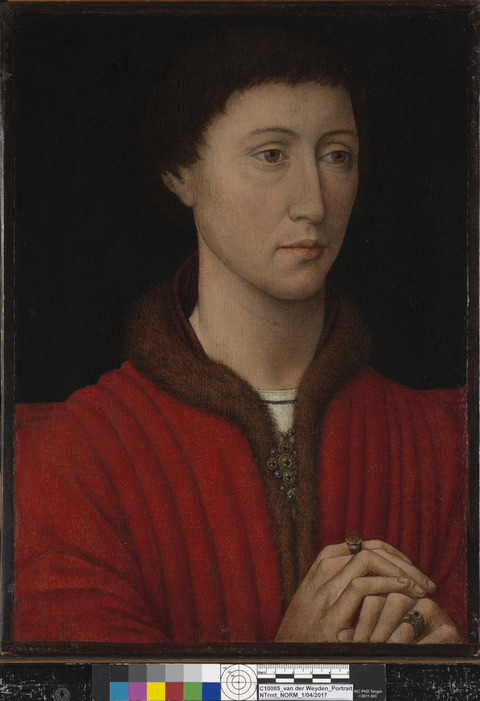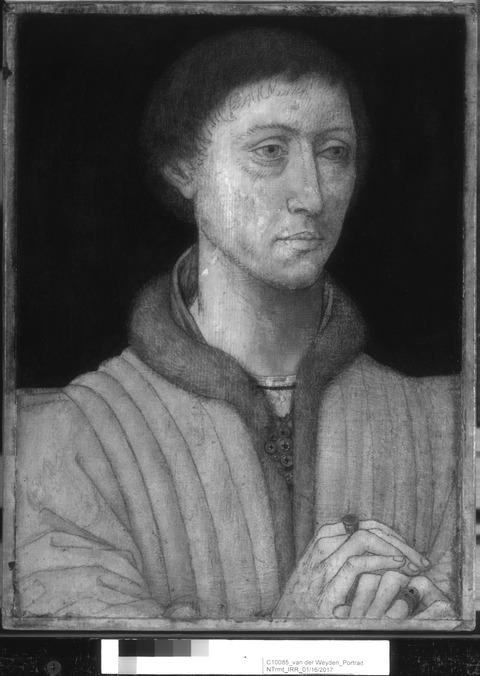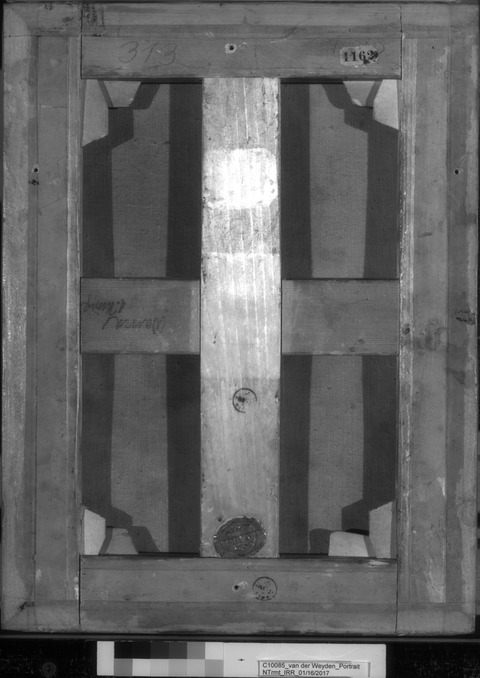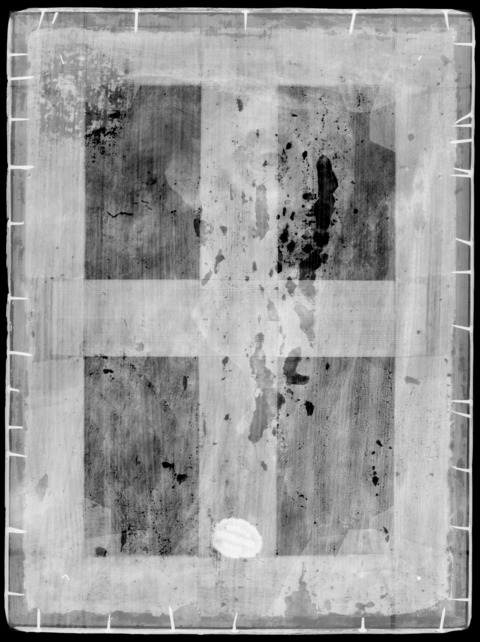Overview
Accession number: 2018.27
Artist: Follower of Rogier van der Weyden
Title: Portrait of a Man
Materials: Oil (untested) on panel transferred to canvas
Date of creation: About 1450
Previous number/accession number: C10085
Dimensions: 36.5 × 26.6 cm
Conservator/examiner: Erica Schuler with contributions from Roxane Sperber
Examination completed: 2017
Distinguishing Marks
Front:
None
Back:
Item 1. Legible red seal on the bottom edge of the stretcher’s vertical cross member, which appears to read: “GALERIE / SEDELMEYER / PARIS.”
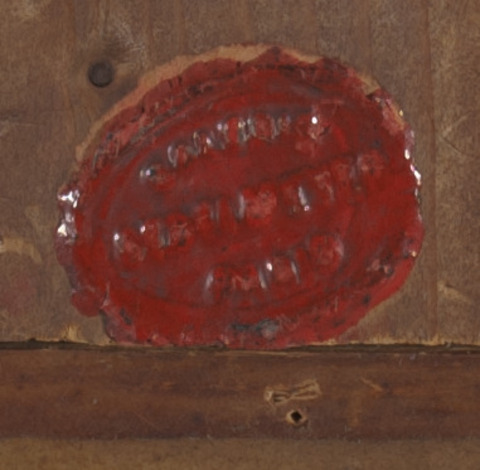
Item 2. Inverted cursive inscription in carbon-based media written on the left side of the stretcher’s horizontal cross member, partially abraded and decipherable under normal illumination with increased clarity under reflected infrared; text reads: “Wawra / 1. März.”
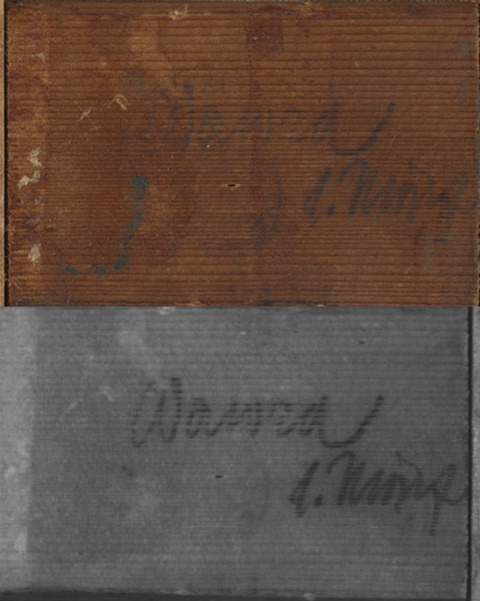
Item 3. Circular stamp in black infrared transparent ink that shows text, reading “Bundesdenkmalamt Wien,” encircling a motif located on the top edge of the stretcher’s vertical cross member. A weak, indecipherable transfer of what appears to be the same stamp shows on the canvas back within the top-left quadrant.
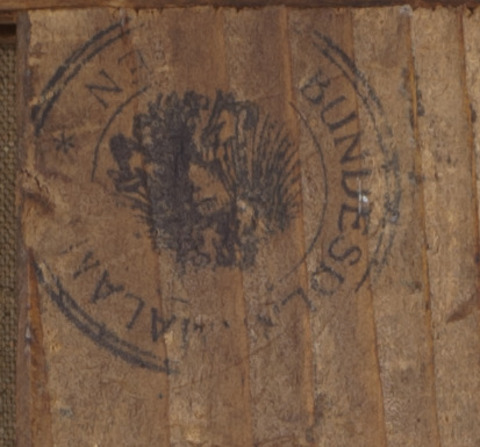
Item 4. Handwritten inventory number “313” in what appears to be blue wax crayon located on the left side of the stretcher’s top member.
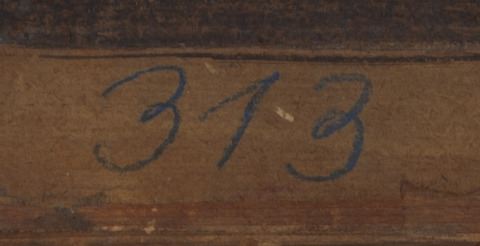
Item 5. Circular stamps in black carbon-based ink with cross motif located below center on the stretcher’s vertical cross member.

Item 6. Circular stamps in black carbon-based ink with cross motif located at center on the stretcher’s bottom member.
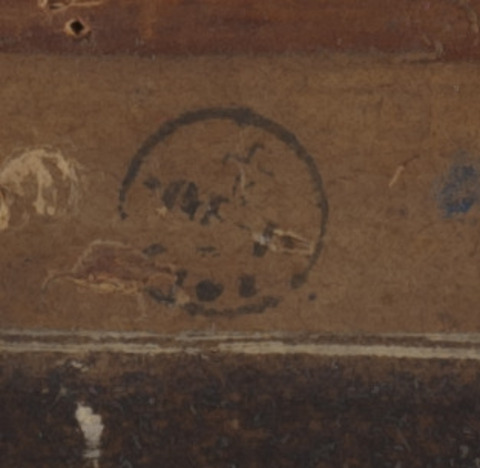
Item 7. Inventory number “1162” printed in carbon-based ink on a white paper label adhered to the far-right end of the stretcher’s top member.
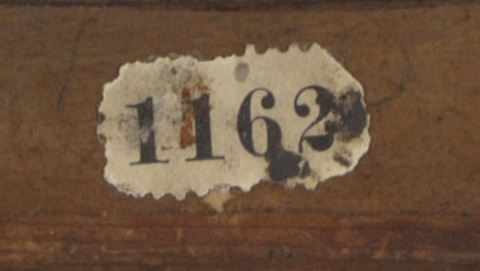
Item 8. Illegible circular stamp in infrared transparent ink on the bottom-left quadrant of the canvas back.

Item 9: Illegible circular stamp in infrared transparent ink on the upper-left quadrant of the canvas back.
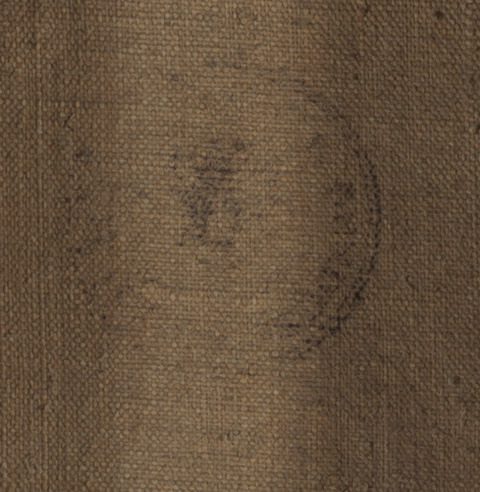
Other:
Detached labels adhered to cardstock and filed within the IMA’s historical files.
Item 10. Handwritten black ink paper gallery label that includes a circular and partially legible ink stamp: “Rogier v. d. Weyden / 1400 – 1464. / Brustbild e. jungen Mannes / 40 × 30 54 × 42 / 1897. N.” The stamp appears to bear the script “GALERIE WEBER HAMBURG” encircling the number “969” written in black ink at its center.
Item 11. Paper label with a printed blue border and faded, partially legible inscription written in black ink that appears to read as “_90 / R.v.d. Weyden.”
Item 12. Extremely damaged paper label with an illegible inscription written in ink.
Summary of Treatment History
Documentation suggests a series of condition assessments and treatments were carried out on the collection around the time the works were moved from the Clowes' residence to the IMA in 1971. A condition report by Paul Spheeris in October of that year, likely carried out before the paintings were relocated, described the painting as “O.K.” He wrote that no treatment was necessary at that time.1

A second condition assessment was carried out upon arrival of the paintings at the IMA. This assessment states the portrait was received at the museum in good condition, requiring no structural or aesthetic work.2 Four years later, the Intermuseum Conservation Association recommended the removal of a discolored surface coating and inpainting to enhance the painting’s appearance. Visible light and ultraviolet-induced visible fluorescence examination suggest that the recommended treatment was never carried out.3 The only documented treatment occurring since its arrival on permanent loan to the IMA, courtesy of The Clowes Fund, involved the minor removal of two white accretions from the painting’s surface in response to a 3 November 1998 damage report.4
However, the painting’s physical history is more complicated than retained records reveal. Records detailing past treatment dates, restoration materials, and techniques have not been preserved, yet visible light examination, infrared reflectography, and X-radiography show that extensive structural and aesthetic interventions have been performed throughout the painting’s history to compensate for severe deterioration and loss. In addition to varnish removal and loss compensation, the painting has undergone extreme structural intervention. Originally executed on a wood panel, the original wood plank was planed away and the picture layer transferred to an auxiliary lightweight plain-woven linen fabric—a restoration technique that, at minimum, likely involved facing; mechanical removal of the wood support via plane and scalpel (painting placed face down on the work surface); and exposure to heat, pressure, and moisture during the lining process. Now glue-paste lined to the auxiliary support and tensioned to a six-member expandable wood stretcher, the resulting dimensions of the picture measure slightly larger than the original painting.
Current Condition Summary
Despite extensive previous damage visible in a photograph from 1930 (tech. fig. 10), the painting appears to be in stable aesthetic and structural condition. Transferred to a fabric support, the original wood panel has not been preserved and a plain-woven linen fabric auxiliary support tensioned to a six-member expandable wood stretcher now supports the picture layer. The painting has suffered extensive past loss of the ground and paint layers. The X-radiograph shows damage and loss throughout the proper left side of the composition as well as within a circular loss measuring approximately 5.5 cm in diameter in the proper top-right corner. Old fill material and retouching covers damage and visually integrates texture and color with the surrounding original materials. However, upon close examination, the surface shows an abraded and flattened aesthetic, resulting from the transfer process, when examined under magnification and in raking light (tech. fig. 11). The paint layer retains the texture of the original panel’s vertical grain as well as the network of craquelure associated with the original support, yet a prominent weave texture from the lining canvas is now a discernable characteristic of the painting’s aesthetic.
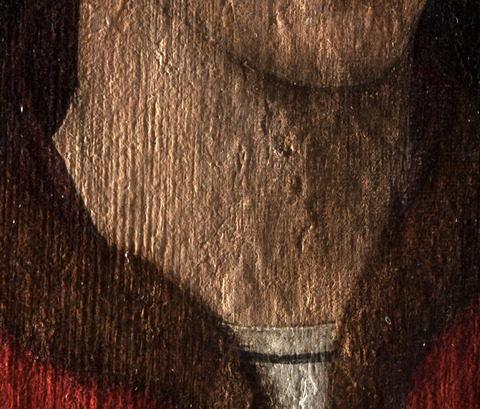
Methods of Examination, Imaging, and Analysis
| Examination/Imaging | Analysis (no sample required): | Analysis (sample required): |
|---|---|---|
| Unaided eye | Dendrochronology | Microchemical analysis |
| Optical microscopy | Wood identification | Fiber ID |
| Incident light | Microchemical analysis | Cross-section sampling |
| Raking light | Thread count analysis | Dispersed pigment sample |
| Reflected/specular light | X-ray fluorescence spectroscopy (XRF) | Fourier-transform infrared spectroscopy (FTIR) |
| Transmitted light | Macro X-ray fluorescence scanning (MA-XRF) | Raman microspectroscopy |
| Ultraviolet-induced visible fluorescence (UV) | ||
| Infrared reflectography (IRR) | Gas chromatography–mass spectrometry (GC-MS) | |
| Infrared transmittography (IRT) | Scanning electron microscope -energy dispersive X-ray spectroscopy (SEM-EDS) | |
| Infrared luminescence | Other: | |
| X-radiography |
Technical Examination
Description of Support
Analyzed Observed
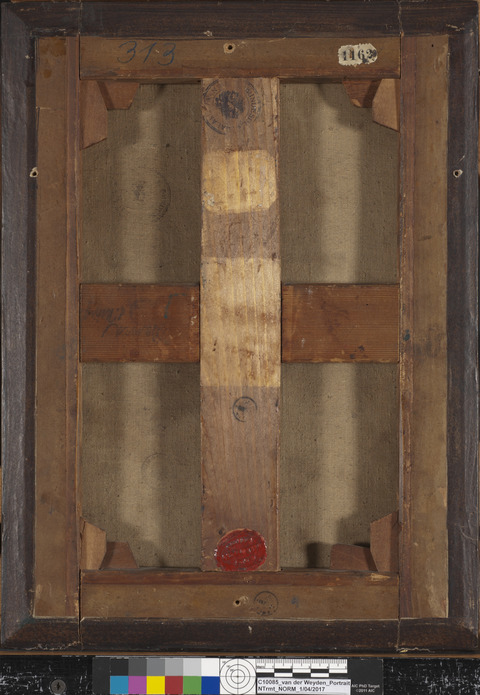
Material Type (fabric, wood, metal, dendrochronology results, fiber ID information, etc.):
The painting was originally executed on a vertically grained wood panel support but is presently glue-paste lined to a fine, plain-woven auxiliary canvas tensioned and attached to a six-member expandable stretcher with metal tacks. By examining the ridge of ground and paint surrounding the perimeter of the picture plane—a feature that relates to the painting’s original construction and the artist technique—approximate dimensions of the original panel are estimated to be 35 × 25.2 cm.
Characteristics of Construction/Fabrication (cusping, beveled edges of panels, seams or joins, battens):
Although uneven paint ridges along each edge help to approximate the original size of the picture plane, the panel’s original dimensions have not been preserved. The uniformity of the extant vertical grain texture suggests that the panel was likely radially sawn.
Thickness (for panels or boards):
Unknown
Production/Dealer’s Marks:
None observed, none preserved
Auxiliary Support:
Original Not original Not able to discern None
Weave (structure, weight, thread thickness, etc):
The transferred picture layer is glue-paste lined to a fine, plain-weave auxiliary canvas that is tensioned and attached to a six-member expandable stretcher with metal tacks (see tech. figs. 12 and 13).
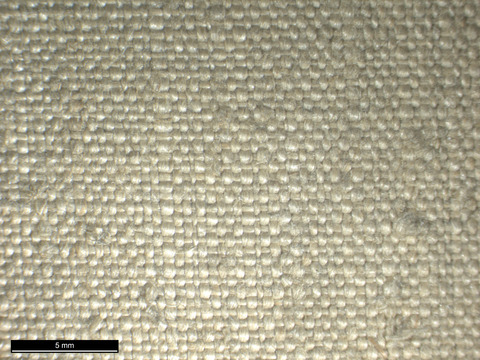
Condition of Support
The painting’s original support has not been preserved. At present, the auxiliary canvas and stretcher are stable and in good structural condition. Combined with the rigidity of the glue-paste lining, the tensioned canvas support holds the picture layer securely in plane. Extensive damage was incurred from during the transfer; however, since the transfer was completed, the painting appears to have remained in stable condition.
Description of Ground
Analyzed Observed
Materials/Binding Medium:
Cross-section analysis confirmed the presence of a multilayered ground structure.
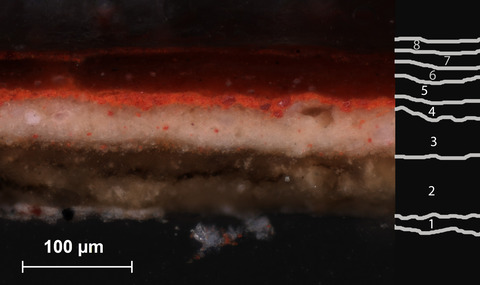
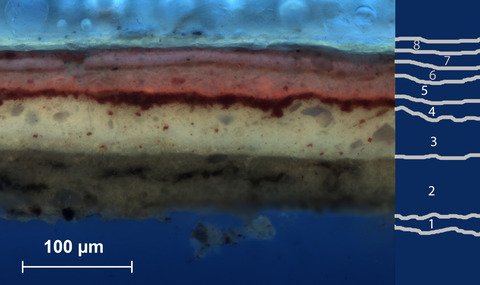
A thin layer containing lead white appears unevenly along the bottom of all cross sections observed (tech. figs. 14, 15, layer 1; tech. fig. 17). A continuous, thickly applied chalk ground layer (tech. fig. 17, layer 2; tech. fig. 19) is present across the panel. This layer shows visual characteristics consistent with a ground bound in animal glue. A thin imprimatura layer, containing lead white and some vermilion (tech. figs. 17, 18), is also present in cross section over the chalk ground layer. Mercury was identified in all locations analyzed with XRF suggesting the imprimatura has been applied to the entire painting surface (see XRF Analysis).
Color:
The off-white, glue-based ground has been toned overall with a light pink imprimatura. The presence of vermilion in the imprimatura was confirmed using EDS analysis (tech. fig. 21). The red pigment particles vary in size and are discernable under low-power magnification as relatively coarse and translucent particles. Pink imprimatura layers have been observed on several works attributed to Rogier van der Weyden.5
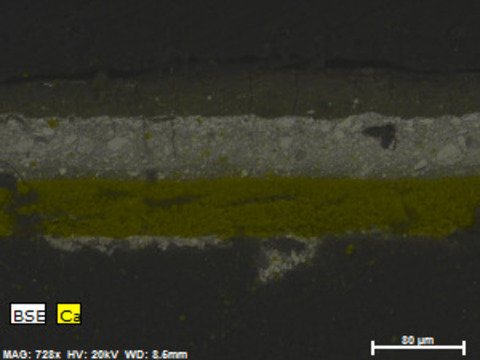
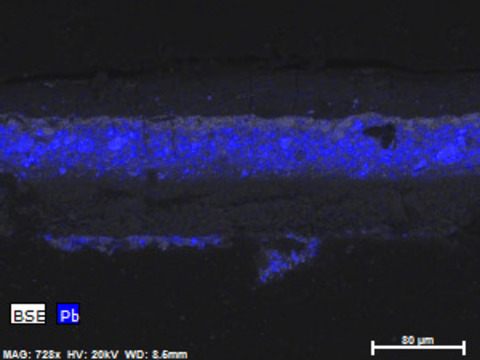
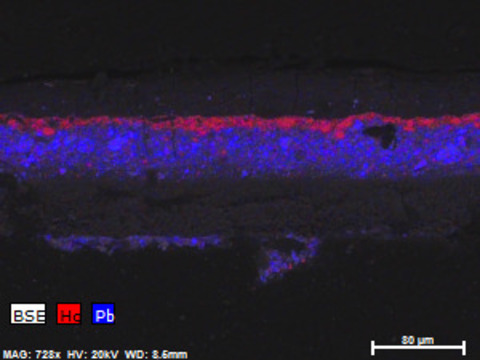
Application:
Given that the original support was a wood panel, the uneven lead-white layer (tech. fig. 17, layer 1) may have been used to fill dips in the wood grain of the panel. This layer may have been applied and scraped down to create an uneven application. The calcium carbonate ground (tech. fig. 17, layer 2) was likely brush applied in multiple layers, and once dry, finished with a scraper or abrasive to achieve a smooth, uniform surface that concealed the texture of the panel. The toned imprimatura (tech. fig. 17, layer 3) was brush applied to reduce the absorbency of the ground and adjust the visual effect. The infrared reflectogram shows broad brushwork independent of the painted design that appear to relate to the imprimatura beneath passages of underdrawing.
Thickness:
The ground layer was thinly applied. The imprimatura layer also appears to be thinly applied.
Sizing:
Although not visible in cross section, multiple layers of animal-glue size would likely have been applied to the panel prior to ground application.
Character and Appearance (Does texture of support remain detectable/prominent?):
The picture layer retains the texture of the original panel’s vertical grain as well as the network of craquelure associated with the original support, yet a prominent weave texture from the lining canvas is now a discernable characteristic of the painting’s aesthetic—both vertical grain and gridded weave texture can be observed.
Condition of Ground

The ground appears to be in stable condition. The ground and paint layers appear to be adequately supported and show no indication of incipient deterioration; however, several old losses (large and small) of ground and paint are visible in the X-radiograph (tech. fig. 19). Extensive damage and loss show throughout the proper left side of the composition as well as within a circular loss measuring approx. 5.5 cm in diameter in the proper top-right corner. Old fill material and old retouching cover damage and visually integrate texture and color with surrounding original materials; however, upon close examination, the surface shows marked alterations resulting from the transfer process.
Description of Composition Planning
Methods of Analysis:
Surface observation (unaided or with magnification)
Infrared reflectography (IRR)
X-radiography
Analysis Parameters:
| X-radiography equipment | GE Inspection Technologies Type: ERESCO 200MFR 3.1, Tube S/N: MIR 201E 58-2812, EN 12543: 1.0mm, Filter: 0.8mm Be + 2mm Al |
|---|---|
| KV: | 21 |
| mA: | 3 |
| Exposure time (s) | 60 |
| Distance from x-ray tube: | 36” |
| IRR equipment and wavelength | Opus Instruments Osiris A1 infrared camera with InGaAs array detector operating at a wavelength of 0.9-1.7µm. |
Medium/Technique:
With the exception of the proper right sleeve, the painted image parallels the contours defined within the boldly traced underdrawing that is readily apparent in the infrared reflectogram but also partially visible to the unaided eye through the aged and degraded paint. Examination of the infrared reflectogram shows systematic and bold lines delineating the main contours of the composition—gross forms that are further developed with simple gestural hatching (note the sitter’s face and hands, tech. figs. 20, 21). The broken and unsteady nature of the lines coincide with the textured brushwork of the imprimatura, indicating that after the imprimatura was left to dry, the artist likely transferred his design directly onto its surface using a template.
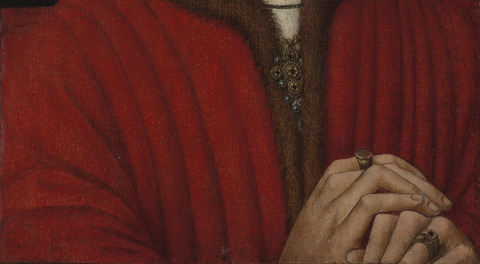
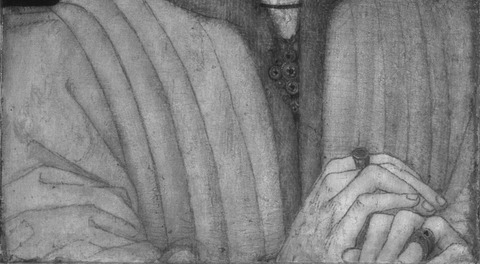
A cross-section sample from the eyebrow of the figure shows the underdrawing directly applied to the imprimatura (tech. fig. 22, layer 4). Aluminum and silicon were identified in the underdrawing layer using EDS mapping of the cross section (tech. figs. 23–25). The presence of aluminosilicates in the black, infrared-absorbent underdrawing material suggests the use of natural black chalk.6
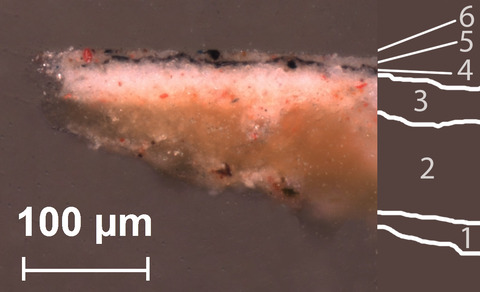
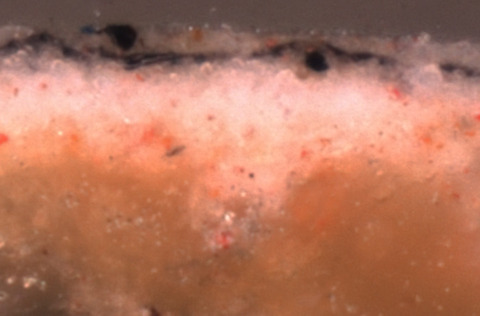
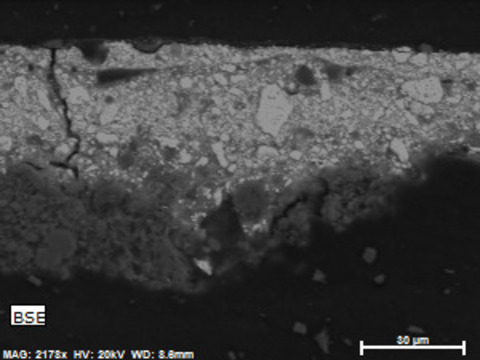
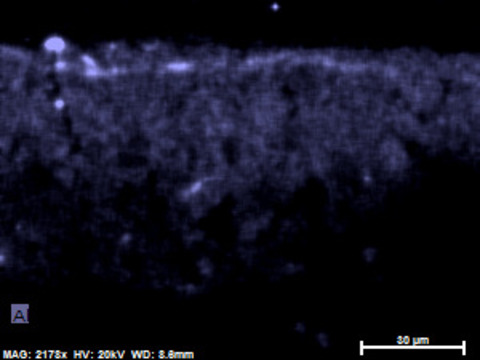
Extensive pentimenti were not noted. However, a slight shift in contour can be observed in the proper right pinky finger. A marked adjustment from underdrawing to paint application can also be observed in the rendering of fabric folds within the proper right sleeve. Furthermore, the aesthetic character of line shifts between the left and right eyes—an effect of a restorer’s hand and not the artist, as the sitter’s proper left eye was extensively compromised by past damage.
The use of hatching to establish form appears to be restricted to facial features, while form within the clothing, jewelry, and hair was established during the painting stage. Traced lines appear solid, bold, and definitive while hatching is less pronounced.
Pentimenti: With exception of the sitter’s proper right sleeve, comparison of the visual composition with that of the infrared reflectogram indicates that the artist did not deviate from the original traced design.
Description of Paint
Analyzed Observed
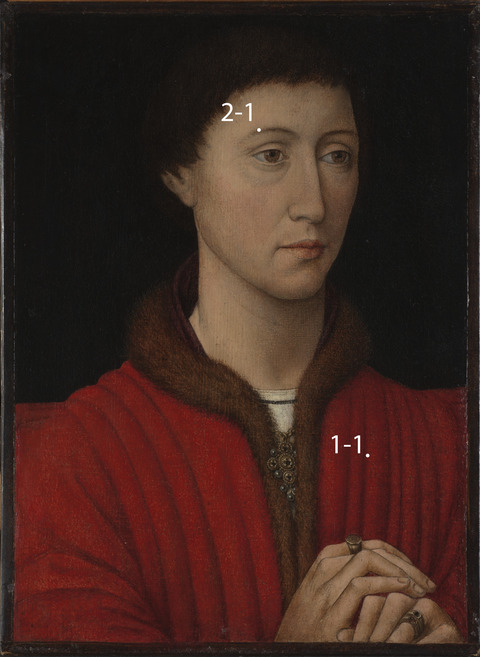
Application and Technique:
The artist applied the paint in thin layers over the top of a thin imprimatura and bold underdrawing. The paint surface is heavily abraded and has been markedly altered by past treatment campaigns making it difficult to discern original surface characteristics. Observation under low-power magnification reveals that the artist established form by building up multiple layers of opaque paint and reinforcing details and shadows with dark translucent glazes. Layers of translucent paint allowed the toned imprimatura to show through (tech. fig. 27).
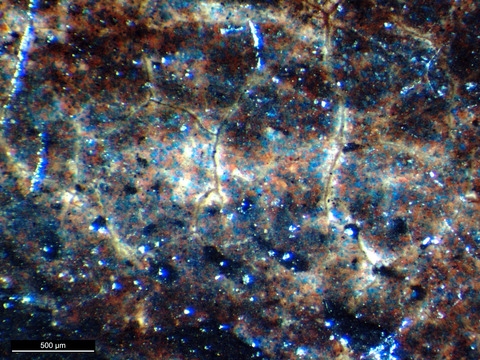
Painting Tools:
The paint was applied in small brushstrokes (tech. fig. 28)
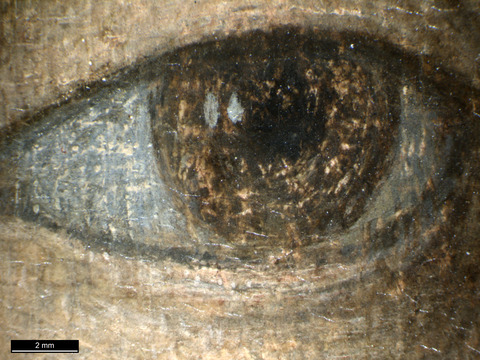
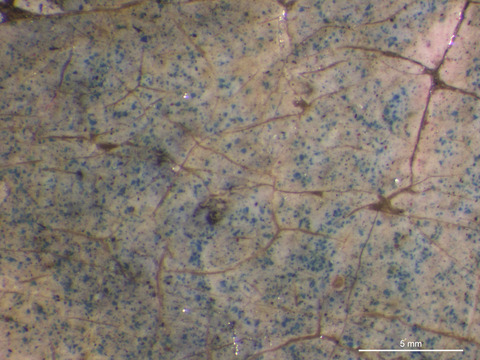
Binding Media:
Visual characteristics of the paint are consistent with oil-based binding media; however, further analysis is necessary to identify the materials present.
Color Palette:
XRF analysis (tech. fig. 30) coupled with cross-section sampling (tech. fig. 26), and analysis using SEM/EDS, suggest the use of pigments which were available to fifteenth-century artists. The artist employed a fairly simple color palette comprised primarily of white, black, red, blue, brown, and yellow. Coarse blue pigment particles can be observed under magnification in the whites of the sitter’s eyes (tech. fig. 29). XRF detected copper in this location, suggesting the blue particles are azurite. A strong peak for mercury was identified in the cloak, suggesting the use of vermilion to paint the red garment. Cross section 1-1 (tech. fig. 14) from the cloak shows a bright layer of vermillion was applied to the imprimatura (tech. fig. 14, layer 4; tech. fig. 18). Over this layer, several layers of dark red paint, which appear to be red lakes, were applied (tech. fig. 14, layers 5–6). Tin was identified using XRF in the highlight of the yellow ring, suggesting the use of lead-tin yellow to create the gold appearance. Iron was also identified using XRF in the brown fur collar as well as throughout other areas of the painting, suggesting the abundant use of iron oxide (earth pigments). Carbon black was likely used in the background, although this cannot be confirmed using XRF.
XRF Analysis:
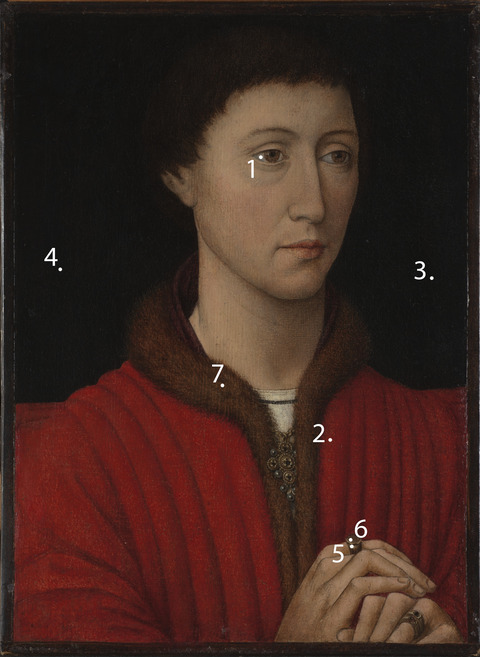
| Sample | Location | Elements | Possible Pigments |
|---|---|---|---|
| 1 | White of proper right eye | Major: Pb, Cu Minor: Trace: Hg, Fe, Ca | Lead white, azurite, trace of iron oxide (earth pigments), trace of vermilion (possibly from imprimatura), trace of calcium (likely from ground). |
| 2 | Red cloak | Major: Pb, Hg Minor: Fe, Ca Trace: Cu | Lead white, vermilion, iron oxide (earth pigments), calcium (likely from ground), trace of copper likely impurity. |
| 3 | Black background (right side) | Major: Pb, Hg Minor: Fe, Ca, Cu Trace: | Lead white, possibly carbon black, vermilion (possibly from imprimatura), iron oxide (earth pigments), calcium (likely from ground), minor trace of copper containing green or azurite (or impurity). |
| 4 | Black background (left side) | Major: Pb, Hg Minor: Fe, Ca, Cu Trace: | Lead white, likely carbon black, vermilion (possibly from imprimatura), iron oxide (earth pigments), calcium (likely from ground), trace of copper containing green or azurite (or impurity). |
| 5 | Yellow highlight on ring | Major: Pb Minor: Fe, Sn, Ca, Hg Trace: Cu | Lead white, lead-tin yellow, iron oxide (earth pigments), vermilion (possibly from imprimatura), calcium (likely from ground), trace of copper containing green or azurite (or impurity). |
| 6 | Yellow midtone on ring | Major: Pb Minor: Fe, Sn, Ca, Hg Trace: Cu | Lead white, lead-tin yellow, iron oxide (earth pigments), vermilion (possibly from imprimatura), calcium (likely from ground), trace of copper containing green or azurite (or impurity). |
| 7 | Brown fur trim | Major: Pb Minor: Fe, Ca, Hg Trace: Cu | Lead white, iron oxide (earth pigments), vermilion (possibly from imprimatura), calcium (likely from ground), trace of copper containing green or azurite (or impurity). |
Table 1: Results of X-ray fluorescence analysis conducted with a Bruker Artax microfocus XRF with rhodium tube, silicon-drift detector, and polycapillary focusing lens (~100 μm spot).
*Major, minor, trace quantities are based on XRF signal strength not quantitative analysis
Surface Appearance:
As noted above, the paint surface is heavily abraded and has been markedly altered by past structural and aesthetic treatment campaigns. Extensive passages of restorer’s fills and retouching cover losses throughout the composition and extend beyond the original picture layer but remain stable and well matched. The extent of damage is not readily apparent to the unaided eye and only largely realized upon close examination.
Condition of Paint
While cohesion within layers and adhesion between the paint and ground appears secure, the picture layer has experienced extensive past loss and damage related to its history of aggressive interventions, natural aging, and exposure to poor environmental conditions. Natural age-related craquelure that is associated with the original panel support is present throughout the original material as is vertical grain texture; however, the surface is significantly altered as a result of the transfer process and a nonoriginal weave pattern permanently transforms the painting’s aesthetics. The painting has likely been cleaned several times in the past, and as a result, the original paint has sustained abrasion. Approximately 1 cm of the picture plane is concealed behind framer’s tape along each edge.
Description of Varnish/Surface Coating
Analyzed Observed Documented
| Type of Varnish | Application |
|---|---|
| Natural resin | Spray applied |
| Synthetic resin/other | Brush applied |
| Multiple Layers observed | Undetermined |
| No coating detected |
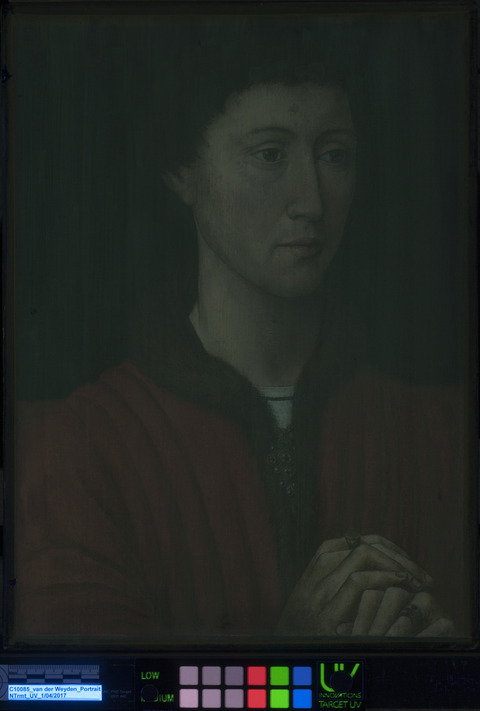
Under ultraviolet-induced visible fluorescence a yellowish-green fluorescence, characteristic of natural resin varnish, is visible across the entire painting (tech. fig. 31). Vertical brushstrokes that span the height of the painting are readily visible under ultraviolet-induced visible fluorescence. The coating was applied in a controlled manner with a wide brush to form a moderately thick film. This layer offers a uniform protective coating.
Condition of Varnish/Surface Coating
Although the varnish has yellowed slightly over time, it remains moderately glossy in sheen and continues to provide adequate saturation of color throughout the composition.
Description of Frame
Original/first frame
Period frame
Authenticity cannot be determined at this time/ further art historical research necessary
Reproduction frame (fabricated in the style of)
Replica frame (copy of an existing period frame)
Modern frame
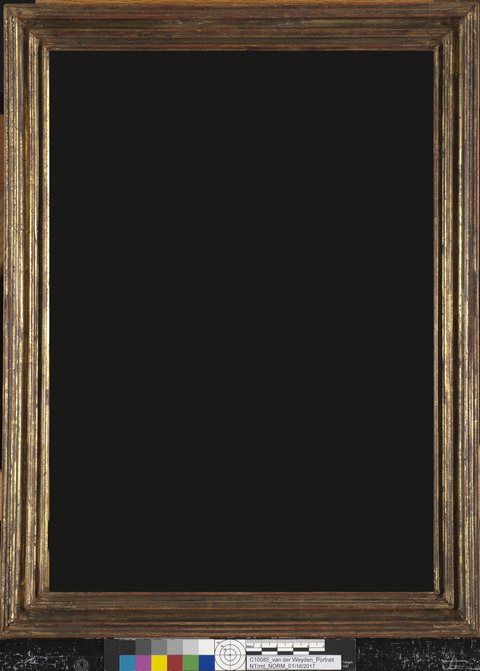
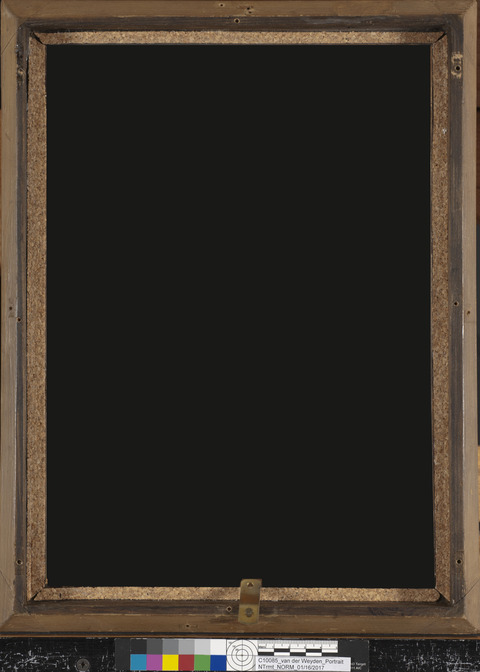
Frame Dimensions:
Outside frame dimensions: 40.4 × 30.4 × 3.5 cm
Sight size: 35 × 24.2 cm
Distinguishing Marks:
None
Description of Molding/Profile:
The frame is a simple cassetta frame with a ribbed profile (tech. fig. 32). The frame is carved wood with a gilded surface.
Condition of Frame
The frame is in relatively good and stable condition (tech. fig. 32, 33).
Notes
-
Paul A.J. Spheeris, “Conservation Report on the Condition of the Clowes Collection,” 25 October 1971, Conservation Department Files, Indianapolis Museum of Art at Newfields. ↩︎
-
Martin Radecki, Clowes Collection condition assessment, undated (after October 1971), Conservation Department Files, Indianapolis Museum of Art at Newfields. ↩︎
-
Intermuseum Conservation Association, “Clowes Collection Conservation Report,” C10085 (2018.27), 8–10 April 1974, Conservation Department Files, Indianapolis Museum of Art at Newfields. ↩︎
-
Described as “spit wads.” David Miller, damage/loss report, C10085 (2018.27), 3 November 1998. Conservation Department Files, Indianapolis Museum of Art at Newfields. ↩︎
-
Rachel Billinge et al., “The Materials and Technique of Five Paintings by Rogier van der Weyden and his Workshop,” National Gallery Technical Bulletin 18 (1997): 72. Accessed 8 March 2019: http://www.nationalgallery.org.uk/technical-bulletin/van_der_weyden1997 ↩︎
-
Timothy David Mayhew, Margo Ellis, and Supapan Seraphin, “Natural Black Chalk in Traditional Old Master Drawings,” Journal of the American Institute for Conservation 49, no. 2 (Fall/Winter 2010): 83–95. ↩︎
Additional Images
